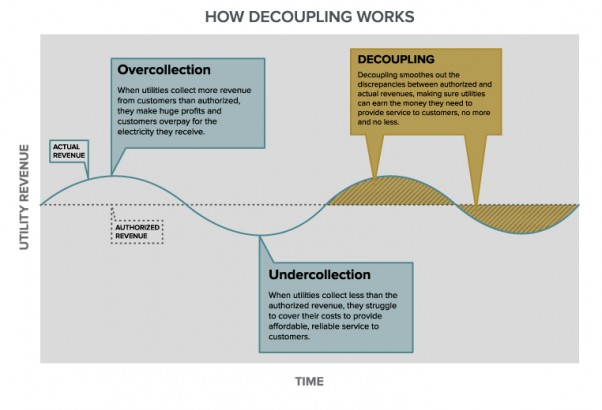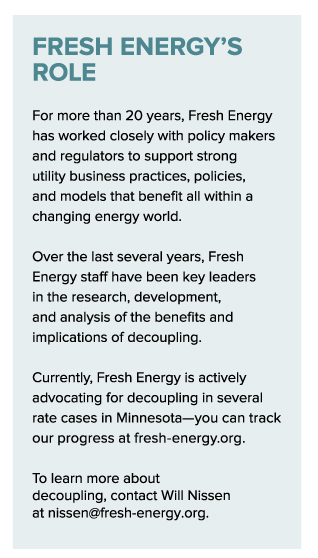Technology and innovation is rapidly changing the way we produce and use energy—making the old way of doing business obsolete. How will utilities keep up? And how will we help them stay solvent, reliable, and forward thinking?
Decoupling: a key tool for change
When you flip the switch, the light goes on. Electricity powers every aspect of modern life, yet we rarely consider the millions of details involved in the generation, distribution, regulation, and cost of selling—and buying—electricity.
Electric utilities are responsible for delivering electricity to every home, business, and public building in the United States. It’s no easy task, especially when outside forces—technology, innovation, and policy and economic changes—make the old ways of doing business obsolete.
Utilities are facing this dilemma today. The old business model—one based on selling more and more electricity—doesn’t work anymore. As demand for energy flatlines and falls, it will take a suite of policy and business tools to keep utilities strong and dependable—and keep the lights on for consumers.
One key tool in the toolbox? Decoupling. A wonky word for a simple concept.
What is decoupling?
At a basic level, decoupling is an accounting tool that ensures utilities collect the amount of revenue they’re allowed by state regulators—no more and no less.
What we pay for electricity depends on a rate approved by regulators. This rate is based on the anticipated amount of energy customers will use in the future; regulators and utilities must plan ahead so that utilities can develop a plan to provide steady power that covers their costs at the same time. Without decoupling, utilities collect revenue based on only these predicted usage numbers.
But the actual amount of energy customers use—and the actual amount of money utilities bring in through rates—may be higher or lower than forecasted for a host of reasons, including the implementation of energy efficiency measures, increased energy conservation, local power generation like small wind and solar, and even weather.
With decoupling, utilities and regulators compare the following two numbers:
- the amount of energy customers were predicted to use in the last year
- the amount customers actually used
Or, from a utility’s perspective, the amount of electricity it thought it would sell compared to the amount of electricity it actually sold.
For example, if states have a decoupling policy in place, and actual electricity sales were higher than expected, the utility would lower rates slightly the next year to refund customers the extra money they paid.
If electricity sales were lower than utilities and regulators expected, the utility increases rates slightly the next year to make up the difference.
How decoupling benefits customers
Decoupling provides a host of benefits to consumers. Primarily, it protects ratepayers’ pocketbooks by making sure utilities don’t rake in exorbitant profits on the backs of its customers. At the same time, it ensures safe and reliable electricity at the flip of a switch.
Additionally, since they provide a basic and necessary service to homes and businesses, utilities can be strong champions of energy efficiency and local power production—two things that can lower consumer energy bills and increase clean energy. The current utility business model doesn’t encourage utilities to embrace efficiency and customer self-generation since these measures would cut into their profit stream.
Removing this disincentive with tools like decoupling can remove a utility’s wariness of innovations that can reduce the amount of electricity customers have to buy. This can transform a utility from one that simply follows the rules to one that actively helps customers save energy and money.
How decoupling benefits utilities
Decoupling also benefits utilities by relieving the following two critical pressures:
- the need to sell increasing amounts of energy to cover the costs of generation and infrastructure investments and the costs of providing electricity to customers
- the inherent motive to sell more energy to increase profits
Relieving these two pressures allows utilities to see the benefit of alternative business models and eases the transition toward whatever is coming next. Under decoupling, utilities no longer have a justifiable wariness towards consumption-reducing efforts.
This can lead to utilities that aggressively pursue efficiency measures, for example, rather than simply complying with state policy requirements because they have to. For example, the investor-owned electric utility Idaho Power implemented a decoupling mechanism in 2007 and subsequently tripled investments in energy efficiency measures—saving customers money.
Decoupling for electric utilities is not a new policy in the United States. As of August 2013, 15 states and the District of Columbia have implemented electric decoupling policies.

CLICK FOR LARGER IMAGE
Moving ahead
In our rapidly changing energy world, it’s unclear what the utility of the future will look like, and what types of services it will provide.
However, it’s clear that the current business model reliant on selling more and more electricity is no longer compatible with today’s energy landscape. Furthermore, a utility increasingly worried about selling certain amounts of energy to cover its operating costs will be more and more resistant to changes to its business model in the future.
Decoupling can break this reliance on increasing electricity sales and open the door to new ways for utilities to remain economically strong while providing affordable, reliable electricity service.


